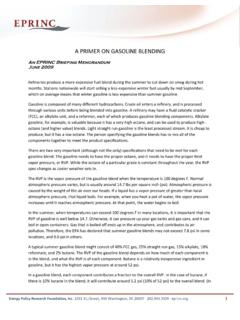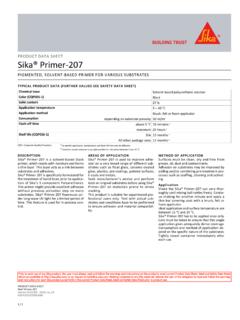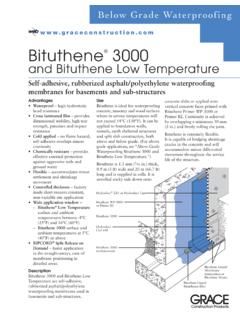Transcription of A Primer on the Canadian Oil Sands - EPRINC
1 A Primer on the Canadian Oil Sands An EPRINC Briefing Memorandum November 2010. Overview Canadian oil Sands have long been recognized as one of the world's largest endowments of oil resources with over 170 billion barrels in place. The resource endowment places Canada second only to Saudi Arabia. Canada's oil Sands are located in Alberta, and unlike conventional crude oil, the oil Sands come in the form of bitumen, a heavy, thick, and viscous substance that requires more intensive extraction techniques than traditional oil production. Oil Sands are produced either from surface mining or in situ processes (see Figure 1). About 80 percent of the recoverable oil Sands reserves can be extracted using in situ methods, which in contrast to surface mining, cause less damage to the local environment. SAGD (Steam Assisted Gravity Drainage) is the most common form of in situ production and is energy intensive because it uses steam generated from natural gas to heat the bitumen so it can flow to the surface (see Figure 2 below).
2 About 20 percent of the oil Sands are recoverable through mining operations where oil Sands are scooped from the surface and moved in trucks. Mining methods scar the landscape and have historically required long time periods to complete reclamation programs, particularly given that tailings ponds can take up to thirty years to fully settle. 1 These two methods of production, mining and in situ, contribute higher volumes of greenhouse gas (GHG). emissions than the production of conventional crude oil because of the relatively high energy use and/or removal of the land surface. 1. Tailings ponds are used in mining operations to let fine particles of residual bitumen, clay, and water settle over time. This generally takes years and has come under considerable controversy for its water usage, sanitation, bird deaths and considerably long land reclamation times. Tailings ponds constitute around 50 square miles of land (NEB 2009 info from Terra Simieritsch converted from km). Recent technology from individual companies operating in the oil Sands will allow tailings extractions to settle in weeks instead of years, increasing land reclamation possibilities.
3 Energy Policy Research Foundation, Inc. 1031 31st Street, NW Washington, DC 20007 1. Figure 1. Understanding Canada's Oil Sands Source: EPRINC diagram, information from Government of Alberta. mbd (million barrels per day). Energy Policy Research Foundation, Inc. 1031 31st Street, NW Washington, DC 20007 2. Figure 2. Types of Production Source: SAGD diagram EPRINC , background photo of SAGD and Mining from Microsoft Oil companies engaged in oil Sands production have been exploring alternative extraction processes to address Canadian regulatory constraints on GHG emissions. In situ production relies heavily upon natural gas to generate steam and as a result its GHG emissions are higher than surface mining. However, production through surface mining causes much more damage to the land and often draws more public concern and criticism than in situ Because of the public concern over surface mining, combined with growing advancement in in situ technology, production from in situ methods is likely to exceed output over surface mining in the future.
4 In situ operations began less than ten years ago, but have reduced their steam usage by 15 percent since that Since bitumen is viscous oil, it must either be upgraded into a synthetic crude oil (SCO) or diluted with condensate (or another natural gas liquid) so it can flow down a pipe and be transported to a refinery. This latter option has the potential to meet the feedstock requirements of complex refineries because diluted bitumen (also called dilbit) from in situ 2. Mining operations cause more damage to the surface than in situ operations, have considerably long reclamation times for tailings ponds, and also use more water than in situ production. For every one barrel of mined bitumen produced, 2 to 4 barrels of fresh water are needed. For every one barrel of in situ bitumen, .5 barrels of fresh water are needed (CAPP 2009). 3. IHS CERA. September 2010. Special Report on Canadian Oil Sands , Greenhouse Gases, and US Oil Supply.. Energy Policy Research Foundation, Inc.
5 1031 31st Street, NW Washington, DC 20007 3. production is similar to conventional heavy crude. 4 Upgraded bitumen yields a synthetic crude oil that is similar to a light conventional crude. Last year all mined bitumen was upgraded into synthetic crude while just a fraction of in situ bitumen was Figures 7 and 8 illustrate the typical outcome of oil Sands bitumen according to its production method. Figure 3. Typical Outcome for In Situ Produced Bitumen Figure 4. Typical Outcome for Mined Bitumen Source: EPRINC and NEB information. 4. Diluted bitumen can usually be refined by complex refineries with little adjustment. See EPRINC 's paper on The Value of Canadian Oil Sands addressing the benefits of heavy oil Sands to complex US refineries at 5. 9 percent of in situ produced bitumen was upgraded. NEB 2009. Energy Policy Research Foundation, Inc. 1031 31st Street, NW Washington, DC 20007 4. Cost of Production Rising oil prices have made the once uneconomic oil Sands production profitable and have allowed for increased investment and significant advances in technology.
6 Estimates vary on the cost of production for a barrel of Canadian oil Sands and this is understandable given the different forms in which a barrel is produced and whether or not the bitumen is upgraded. In 2005 the National Energy Board 6 assessed the supply and operating costs for producing a barrel of Canadian oil Sands . Figure 9 shows the estimated operating and supply costs by extraction method. Costs have been converted from Canadian 2005 dollars to US 2010 dollars. (Note that in 2005, the price for a barrel if oil was in the $40 range.) Supply costs here include operating costs as well as capital costs, taxes, royalties, and a return on investment. Figure 5. Estimated Operating and Supply Costs by Recovery Type Dollars per Barrel at Plant Gate Crude Operating Supply Type Cost Cost Cold Production-Wabasca Seal Bitumen 6 to 8 13 to 17. Cold Heavy Oil Production with sand (CHOPS)- Cold Bitumen 7 to 9 15 to 18. Lake Cyclic Steam Stimulation (CSS) Bitumen 9 to 13 19 to 22.
7 Steam Assisted Gravity Drainage (SAGD) Bitumen 9 to 13 17 to 20. Mining/Extraction Bitumen 8 to 11 17 to 19. Integrated Mining/Upgrading Synthetic 17 to 20 33 to 37. 7. Source: EPRINC conversion given NEB Info , Bank of Canada, Nominal Broad Dollar Index, rounded to nearest whole number 6. The National Energy Board (NEB) is an independent federal agency established in 1959 by the Parliament of Canada to regulate international and interprovincial aspects of the oil, gas and electric utility industries. The purpose of the NEB is to regulate pipelines, energy development and trade in the Canadian public interest . The NEB is accountable to Parliament through the Minister of Natural Resources Canada. 7. As defined by the NEB: Operating Costs- Cash costs of operation ; Supply Costs- All costs associated with production, including operating cost, capital cost, taxes, royalties and a rate of return on investment. Supply costs are stated as a range, reflecting variables such as: reservoir quality, depth of the producing formation, project size, recovery method and operating parameters.
8 Energy Policy Research Foundation, Inc. 1031 31st Street, NW Washington, DC 20007 5. As the above table indicates, costs vary according to the production process. The production of oil Sands is subject to more cost based risk than conventional oil production. Energy, material, and labor costs can bring about large swings in the cost of production. 8 Extraction methods such as in situ which use SAGD, require a significant amount of natural gas a rise in natural gas prices is a therefore a cost risk in the production process. Furthermore, while all bitumen produced from mining operations is upgraded, only a fraction of in situ produced bitumen is upgraded. The rest of the bitumen is blended, often with condensate, so it can be sent via pipeline. Blending costs can therefor impact the cost of production for some in situ produced bitumen. While production costs are subject to a number of inputs, improvements in extraction technologies have the capability to reduce costs in the future.
9 9. GHG Emission Concerns Because of their high energy use and land disturbance, producing Canadian oil Sands emits higher levels of GHGs than conventional crude production. Estimates of the contribution of GHG emissions from the production of oil Sands when compared to the production of conventional crude oil vary considerably. The results of a DOE study (replicated in Figure 6. below) showed that upstream oil Sands GHG emissions were roughly four times greater than the average emissions across all production. However, upstream production is responsible for only a small fraction (usually around20 percent) of GHG emissions on a well-to-wheel basis. Oil Sands production emits between five and fifteen percent more GHGs than conventional crude on a well-to-wheels basis. In well-to-wheels estimates of GHG emissions, most emissions are associated with the combustion phase of fuel, the end use in the transportation sector. In September 2010 Cambridge Energy Research Associates (IHS CERA) released a report on GHG.
10 Emissions and Canadian oil Sands . CERA reported that GHG emissions for Canadian oil Sands were on average six percent higher than the average crude processed at refineries. The reason for this relatively modest difference in GHG emissions is because oil Sands are often diluted with low emission blend stocks. For example, oil sand imports are roughly 55. percent blended bitumen and 45 percent SCO. Because bitumen must be diluted with condensate (or other natural gas liquids) in order to be transported in the form of blended 8. An analyst from National Bank Financial recently estimated that SAGD (Steam Assisted Gravity Drainage), a very common method of in situ operation, was profitable at $65 a barrel versus $80 for mining operations. This is likely due to the capital intensity of these projects and the increase in cost of labor and inputs. Last year Royal Dutch Shell PLC said their production costs for a barrel of Canadian oil Sands had risen from $29 a barrel in 2007 to $38 a barrel in 2008 (Shell is primarily invested in mining operations).







